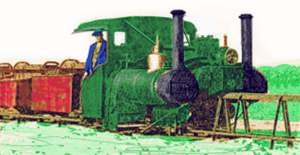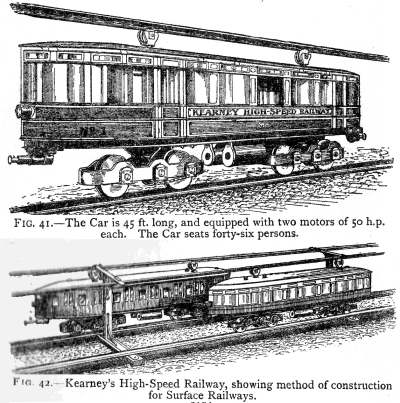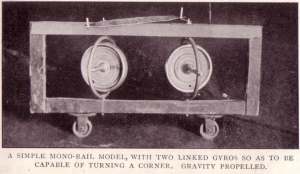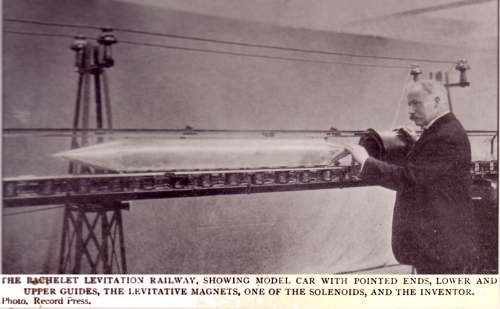The early steam engines were used to replace horses and could handle comparatively large loads on the flat, once they hit any kind of an incline however things became more difficult as the smooth steel wheels running on a smooth steel track tend to slip, wasting power and possibly stressing the equipment. The reverse of this latter problem is also an issue; when goods wagons were 'unfitted' (having nothing but a hand brake) a heavy train could quite easily push a locomotive down hill at ever increasing speed, if the locomotive wheels were locked this had the additional effect of putting a flat on the tyre. One solution was to add a toothed wheel to the engine which engaged with a toothed rail on the track, what is now called a 'rack railway'. This solves the problem of hauling heavy loads up and down gradients (or light loads up and down very steep gradients), but the friction in the system means that only slow speeds are practical.
Given a suitably horizontal path for the line the next thing people demand is high speed travel. In 1903 the Germans built an experimental high speed line between Berlin and Zossen, based on standard track but with two additional guide-rails for stability. The line was 23km long and the two single-car 90 ton units reached speeds of 130mph over short distances. The heavy weight of the units was in part required to keep them on the track and even so the side-to-side oscillations experienced made for an uncomfortable ride. The experiment was closed down after a few months.
The transmission (the mechanics of getting the power from the engine to the wheels) has been a problem for engineers on all forms of motorised land vehicles. The transmission introduces losses and as the components are highly stressed it is a major point of failure. As a result there has been interest in alternative methods of providing propulsion and the use of the aeroplane type propeller gained favour in the early 20th Century. This has been tried with bicycles and cars (see Appendix One - Private Motor Vehicles for illustrations), they worked but such vehicles would have been pretty lethal in towns.
The "Rail Zeppelin" was built by one Frank Kruchenberg in 1931, using an aero propeller instead of mechanical drive to the vehicle wheels. Rather resembling the GWR railcars it ran on conventional track. It was streamlined, sitting very low on the track, and was driven by a BMW aircraft engine which enabled it to achieve a record-breaking 145 MPH. Herr Kruchenberg's machine used conventional rail technology but the problems of keeping the thing on the tracks remained and it was only tried on a dead straight length of track.
The common two-rail railway relies to a great extent on careful preparation of the road-bed to allow water to drain away and leave a stable base for the tracks. This civil engineering is labour intensive and expensive. There has therefore been some interest in systems that avoid this approach, typically utilising a single load-bearing rail supported on pylons. These are generally known as 'monorails' although many designs have additional 'rails' for stability.
One approach that found favour was the tri-rail method, typified by the Lartigue system. The line uses an 'A' shaped frame with a single high rail running along the top to take the weight and two lighter rails arranged on either side of the frame to stabilise the load. The Irish Listowel & Ballybunion Railway, which opened in 1889, was a curious steam powered monorail which employed this methodology. The rolling stock, including the locomotives and passenger coaches, was built in two halves, arranged one to either side of the central rail. The design of the rolling stock was different to say the least, the locomotives had two boilers, one to either side of the centre rail, each with its associated coal bunker arranged to either side of a central water tank. A degree of balancing was required, so if a farmer sent a cow to market he also sent two calves to balance the load; going to market the two calves went on one side with the cow on the other, on the return journey the calves were placed on either side to balance each other. The line survived until 1924.
Fig___ Listowel & Ballybunion Railway mono-rail

Note: In 2003 the Lartigue Monorailway Restoration Committee has now rebuilt a short section of the track and operates a (newly built) double sided loco with two passenger coaches. The half kilometer track opened to the public in Listowel in July of 2003.
The main problem with the Lartigue system was that no way of arranging points was developed so turn tables had to be used to change track, however this system was found to work rather well and a Bill was passed to allow the building of a line using a modified version (the Lartigue-Behr system, with no less than four guide rails as well as the load-bearing top rail) between Liverpool and Manchester. The intention was to run single-car units, offering speeds of up to 120 mph, giving a journey time of 20 minutes (the line was never built as the promoters were unable to raise the capital).
A British engineer called E. W. Chalmers Kearney tried a different approach to provide high speed travel, having one rail under the car with another above to eliminate the side-to-side 'hunting' problem and prevent derailments. He began work on the idea in 1902 and in 1907 had reached the stage of building a working prototype consisting of a length of track with a light weight single car unit capable of carrying 46 seated passengers. His intended production vehicle would have six running wheels under the vehicle, arranged on two three-wheel bogies. The use of light weight cars meant that the actual axle loading worked out at about a quarter that of the standard steam locomotive of the day and the monorail design meant that construction of the track would be simplified and economical. The engine was contained within the wheel (the details of which were a closely guarded secret) and the wheel was to have 'sprung tyres'.
Fig___ Kearney vertical bi-rail prototype and production design

The sketches above are from the book Modern Inventions (in the Romance of Reality series) by V. E. Johnson. The two-rail design would lend itself to modelling, perhaps the ultimate 'might have been' layout.
Most modern mono-rails employ a central concrete beam which the base of the car straddles for stability, this approach can trace its origins to the Lartigue tri-rail system although most of the modern versions run on pneumatic rubber tyred wheels.
The alternative approach for monorails is to suspend the coaches from an over-head line, an early example of this type is the Schwebebahn in Wuppertal, Germany, built in 1901 this line is still operating today. In the 1930s there was a British experimental monorail, using a suspended streamlined passenger car driven by aero propellers at both ends. This was developed by a Mr George Bennie and christened the 'railplane' by the press (the actual name was "The George Bennie Airspeed Railway"). The test track was set up in 1930, running above a section of the LNER line near Glasgow (which remained in operation during the trials). The single car was suspended beneath a lattice box girder construction gantry (built to be capable of carrying a car on either side of the lower framework for bi-directional operation), the whole being supported on steel trestles spaced about 80 feet apart. For reasons not entirely clear to me they added a second, lighter, box girder lattice below the train, which I think may have been involved in braking (but I am not sure).
The plan called for single cars with propellers at both ends although they did think they could couple the hubs of the propellers to produce a train of cars (each driven by its own propellers). A lot of research was done with this machine, notably relating to the use of electric motors, and there was some interest in the idea however the system was not adopted and Mr Bennie went bankrupt in 1937 (the track remained in place until the 1950s).
Fig___ The George Bennie Airspeed Railway

The idea of the suspended monorail remains viable, there are several such systems in use around the world, although non that I am aware of use aeroplane propellers (the Americans did consider setting up a similar propeller driven system in the 1950s to run from New York to Washington but it failed to get funding).
One rather more unusual approach to monorail design is the gyro-stabilised car running on a single steel rail. Shortly before the First World War a chap by the name of Brennan developed a such mono-rail, using gyro-stabilisation to keep the car upright. A full size prototype was built for testing by the military, the theory being that laying a monorail track would be much easier than leveling the ground for a bi-rail system. He used two mechanically linked gyros so when turning a corner the precession did not topple the car over. The prototype proved capable of 22mph and although the vehicle was about 40ft long it managed to go round a 35ft radius curve at full speed. The problems of making bearings strong enough to take the thrust of the heavy gyro was its main weak point and in the event the military adopted the tried and trusted narrow gauge railway system for their purposes.
Fig___ Brennan gyro-stabilised mono-rail

In his book 'The War in the Air' H.G.Wells, evidently much taken with the Brennan experiments, made the gyro-stabilised mono-rail the predominant method of surface transport, operating at speeds of 200mph.
The photo above was scanned from the book Modern Inventions (in the Romance of Reality series) by V. E. Johnson, published about the time of the First World War. He built a working model that would run down an incline on a rail which curved from side to side. At about 7mm to the foot it should be possible to build a working model of the prototype, the photo below is also from Mr Johnson's book and shows the mechanical linkage required. Another candidate for a 'might have been' although the energy stored in the gyros would still represent a hazard for exhibition running.
Fig___ Working model of a Brennan gyro-stabilised mono-rail

The idea of the monorail, supported on columns and hence easier to build and maintain than a two-rail system with its level track bed, has remained popular, although little progress has been achieved to date on large scale systems. In post World War Two America a monorail system was built for the Disneyland theme park running on an inverted T shaped concrete rail.
Fig___ The Disneyland monorail

In the 1960s there was a lot of talk about re-introducing an effective public transport system in Los Angeles and Disneyland offered to extend their system right across the city. The German firm of Alweg also offered to build them a monorail system on the basis they would run it to recover the costs. Both ideas were rejected and in the event (in spite of spending millions on 'research' in to what was required) no mass transit system was built for many years, the final 'tube' railway system has never reached the scale of either of the proposed monorails. It is perhaps worth noting that Los Angeles did at one time have a very effective and profitable privately owned electric tram system, however this was purchased by a consortium of large motor car related firms and closed down.
In the mid 1970s a former British Army Engineer proposed a simple system he called the 'Slider', this used an elevated H section track with the cars hanging on either side in the manner of a plastic curtain rail, giving bi-directional running. The advantage of this design was that the track could be supported on posts running down the centre of the road and the 'tracks' on each side could be curved outwards to the side where the raised platforms could be easily accessed from the pavement. At the time the city of Manchester was investigating ways of providing a direct link between the Piccadilly and Victoria railway stations to the north and south of the town centre. The authorities were seriously considering building an underground 'Pic-Vic' line but the 'Slider' would have been considerably cheaper to build. The larger department stores liked the Slider approach (they felt they could have stations built onto their upper floors) but it was rejected in part because the pylons in the centre of the road represented a hazard to badly driven motor cars. In the event a street-level tram was built (hi-jacking several local railway lines) and the badly driven cars are now routinely crushed by the trams instead.
One alternative to a railway is the 'guided bus way' in which a road going bus is fitted with guide wheels. The bus operates as normal, collecting passengers from the street, then runs into a U shaped concrete channel (where the guide wheels handle the steering) and thereby avoids the congestion on the roads. This idea was promoted by bus manufacturers, and its low investment cost make it attractive to Westminster, but practical problems dogged research into the idea and trams have proved the preferred approach.
One problem that tells against high speed rail travel is friction, the problem is not the power required to overcome it but the need to prevent any bearings over heating (burned out wheel bearings remain a problem on rail systems today). To get round this there have been several attempts to levitate the train so that there are no wheels and their attendent bearings to worry about. The one real problem here is what happens if the power fails when the high-speed vehicle is moving, however technology is providing increasingly reliable systems to counter that threat. In the early years of the 20th century there were experiments using compressed air and high pressure water (no one seems to have considered using the existing canal system, presumably as it was clogged with traffic at the time). Everyone gave up on this approach by the 1920s, but in the 1960s interest returned as the hover craft and linear motor were developed.
Mag-Lev, in which the train is supported by a magnetic field is widely regarded as a 'new thing', in fact the principles of its operation have been known since before the First World War and a working model built by one M. Emil Bachelet was exhibited in London shortly before that war.
In 1824 a chap called Gambey discovered that a swinging magnetic compass needle came to rest more quickly when sitting in a metal box. A man called Arago investigated this and found that good electrical conductors had the greatest effect, finally Faraday discovered that the magnetic field induces electrical currents (called eddy currents) in the metal and that these in turn generate a magnetic field of their own in sympathy with the original field. If the original field is then reversed the induced field will not have time to dissipate and will find itself in opposition to the current driven field. As 'like poles' repel this causes a repulsive effect between the magnet and the metal conductor. An American Professor Elihu Thomson presented a paper in 1890 on the repulsive effect of the induced magnetic field interacting with the main field. Prof Thomson even produced an electrically powered 'gun' (in experimental form), an idea which, in the early 21st century, is being actively developed for military use. To produce a consistent repulsive effect, as required to lift a train, the magnetic field has to be alternating at quite a high frequency and this became practical in the early 20th century. In 1912 M. Bachelet demonstrated the use of eddy currents for cooking by placing a copper 'pan' on a plate under which a coil was generating the oscillating field. M. Bachelet then developed a mag-lev train, using U shaped track above and below the car in which stabilising brushes of shoes would run to keep the car aligned with magnets placed under the lower rail. The magnets on the track are switched in as the train passes and a high frequency oscillating current delivers the required magnetic field to lift the car. To drive the car along the track a series of ring magnets would be set up along the track with the line passing through the centre of each. These rings would be energised as the front of the car entered each ring, this would (in the manner of a solenoid) pull the car forward.
Fig___ Working model of a mag-lev train circa 1912

The model worked but the problems with this system were mainly to do with technology; the cost of the copper coils for the track, the cost and difficulty of providing power to the track, the difficulty in maintaining a reliable magnetic field and the inefficiency of the solenoid-drive.
Technology has advanced however, and with the promise of super conducting magnets and the development of the linear motor interest in mag-lev has returned. Super conducting magnets should provide a much more powerful magnetic field for much less electrical power, making the economics of mag-lev altogether more interesting. The linear motor is a simple concept; a normal electric motor consists of a fixed ring of magnets (called the stator) with a central revolving set of magnets (called the rotor). By laying the stator out as a long strip and putting the rotor magnets on the bottom of the vehicle you get linear operation, hence the term linear motor. This can be coupled with an oscillating magnetic field to provide both traction and lift. The idea was developed by Professor Eric Laithwaite (1921-1997), he took out his first patent in 1956 (a linear motor to drive the shuttle on a weaving loom) and with some government funding he produced the worlds first mag-lev train (popularly known as the 'Tracked Hovercraft' because the initial prototype used the blown-air hovercraft principle to lift it on the track). Early trials of the train looked promising with the prototype reaching speeds of up to 100mph, but in 1973 the government cancelled the project, blaming high costs for little return (apparently unaware of the other industrial uses for the concept). The British did build a fully working commercial system, connecting Birmingham airport and a local station a few hundred yards away, this operated for about ten years, closing in the mid 1990s due to a shortage of spare parts.
Meanwhile other countries have taken a more serious interest in developing the technology, the Japanese were quick to begin experiments and the Germans have built a full size mag-lev test track where they are developing the supporting technologies that will be required for future mag-lev train systems. The German train is suspended less than half an inch away from the track, the body of the train wraps over the edge of the flat roadway so it cannot 'derail'. There are still risks associated with very high speed travel however, at one point during German trials a lorry stalled on the track and the train ran into it causing several deaths. On the plus side however the linear motor drive can serve as a very powerful brake, much more effective than braked steel wheels, so in practice (given sufficient warning) a serious accident could be avoided.
More recently the Chinese (faced with the need for mass long-distance transport) are actively engaged in planning a mag-lev railway system between their major cities. For the moment they have employed the German mag-lev team to build a system between Shanghai and its airport. The Chinese long distance system will be far more energy efficient than aeroplanes and, although liquid hydrocarbon fuels are at the moment very cheap, in the longer term that is likely to be something of an issue. A single mag-lev train can shift very large numbers of people at about 300 mph, aeroplanes can manage 500 mph but carry far fewer people and cannot directly access city centres. Faced with the potential commercial potential South Korea has recently opened a 1km maglev demonstation track and plans to build a similar system as an airport to city link.
At the time of writing there are single beam commuter monorails operating in China, Japan (at least 10, most as city transport systems), Malasia (two commuter lines and a theme park)and Singapore. In Europe most lines operate inside theme parks but in Germany they have a few suspended types (using modern stock resembling 'bendy-busses') and the prototype track for their commercial maglev system. Moscow has a monorail in part of the city, in America there are commuter lines in Las vegas, Memphis, and Honolulu. In Australia Sydney has a commuter monorail. Most of the remainder are in theme parks and connecting airports with nearby towns. In Britain there have been a number of operational monorails in theme parks, the first was at Butlins Skegness(1964-2003) and Merry Hill Shopping Centre, near Birmingham had a monorail (opened in 1991) but it closed in 1996 when it was sold to Australia for use by tourists in Brisbane